The Sandy Bridge Review: Intel Core i7-2600K, i5-2500K and Core i3-2100 Tested
by Anand Lal Shimpi on January 3, 2011 12:01 AM ESTThe 6-series Platform
At launch Intel is offering two chipset families for Sandy Bridge: P-series and H-series, just like with Lynnfield. The high level differentiation is easy to understand: P-series doesn’t support processor graphics, H-series does.
There are other differences as well. The P67 chipset supports 2x8 CrossFire and SLI while H67 only supports a single x16 slot off of the SNB CPU (the chip has 16 PCIe 2.0 lanes that stem from it).
While H67 allows for memory and graphics overclocking, it doesn’t support any amount of processor overclocking. If you want to overclock your Sandy Bridge, you need a P67 motherboard.
6Gbps
Had SSDs not arrived when they did, I wouldn’t have cared about faster SATA speeds. That’s how it worked after all in the evolution of the hard drive. We’d get a faster ATA or SATA protocol, and nothing would really change. Sure we’d eventually get a drive that could take advantage of more bandwidth, but it was a sluggish evolution that just wasn’t exciting.
SSDs definitely changed all of that. Today there’s only a single 6Gbps consumer SSD on the market—Crucial’s RealSSD C300. By the middle of the year we’ll have at least two more high-end offerings, including SandForce’s SF-2000. All of these SSDs will be able to fully saturate a 3Gbps SATA interface in real world scenarios.
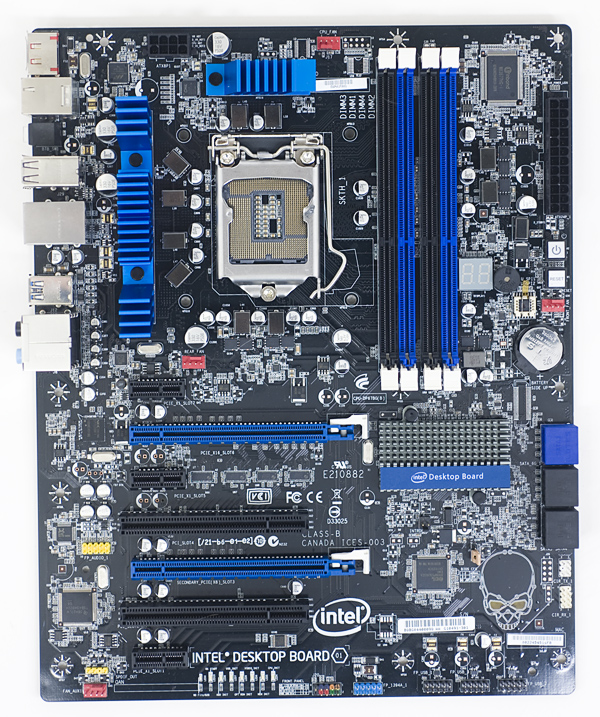
Intel's DP67BG—The blue SATA ports on the right are 6Gbps, the black ones are 3Gbps
To meet the soon to be growing need for 6Gbps SATA ports Intel outfits the 6-series PCH with two 6Gbps SATA ports in addition to its four 3Gbps SATA ports.
I dusted off my 128GB RealSSD C300 and ran it through a bunch of tests on five different platforms: Intel’s X58 (3Gbps), Intel’s P67 (3Gbps and 6Gbps), AMD’s 890GX (6Gbps) and Intel’s X58 with a Marvell 9128 6Gbps SATA controller. The Marvell 91xx controller is what you’ll find on most 5-series motherboards with 6Gbps SATA support.
I ran sequential read/write and random read/write tests, at a queue depth of 32 to really stress the limits of each chipset’s SATA protocol implementation. I ran the sequential tests for a minute straight and the random tests for three minutes. I tested a multitude of block sizes ranging from 512-bytes all the way up to 32KB. All transfers were 4KB aligned to simulate access in a modern OS. Each benchmark started at LBA 0 and was allowed to use the entire LBA space for accesses. The SSD was TRIMed between runs involving writes.
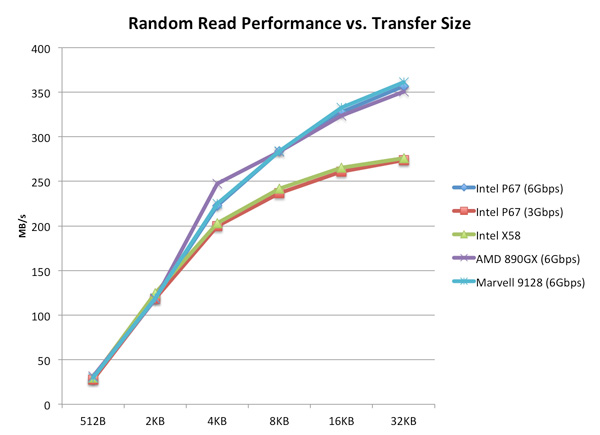
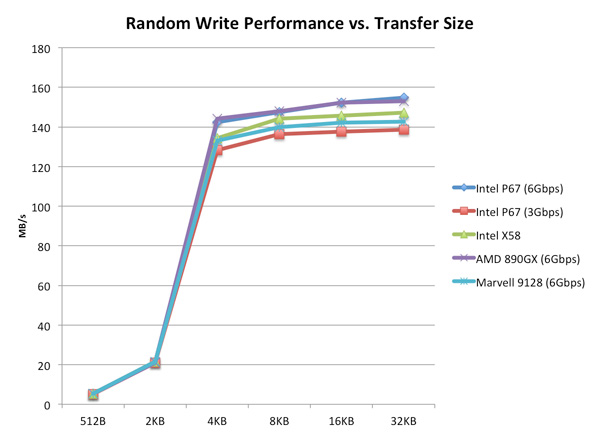
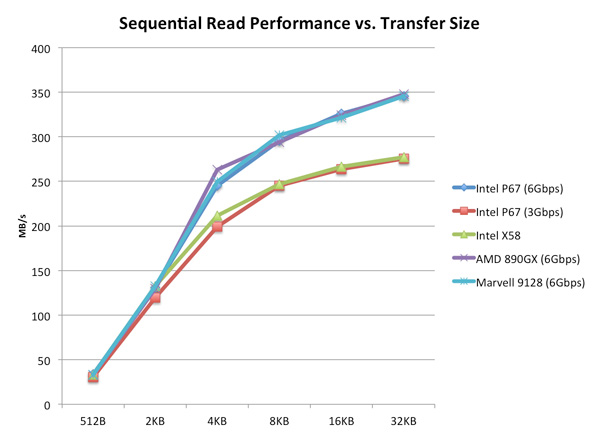
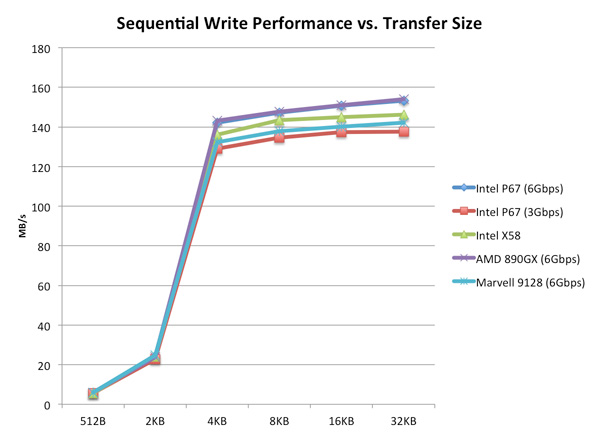
Among Intel chipsets I found that the X58 has stellar 3Gbps SATA performance, which is why I standardize on it for my SSD testbed. Even compared to the new 6-series platform there are slight advantages at high queue depths to the X58 vs. Intel’s latest chipsets.
Looking at 6Gbps performance though there’s no comparison, the X58 is dated in this respect. Thankfully all of the contenders do well in our 6Gbps tests. AMD’s 8-series platform is a bit faster at certain block sizes but for the most part it, Intel’s 6-series and Marvell’s 91xx controllers perform identically.
I hate to be a bore but when it comes to SATA controllers an uneventful experience is probably the best you can hope for.


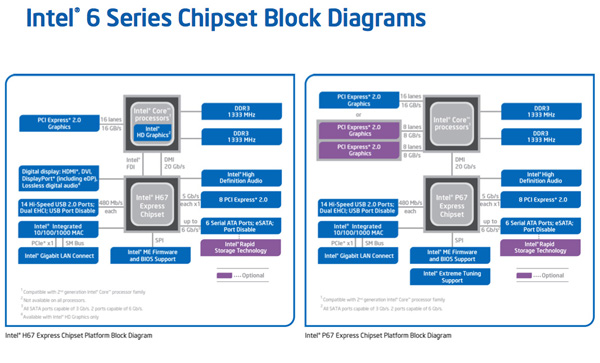








283 Comments
View All Comments
auhgnist - Monday, January 17, 2011 - link
For example, between i3-2100 and i7-2600?timminata - Wednesday, January 19, 2011 - link
I was wondering, does the integrated GPU provide any benefit if you're using it with a dedicated graphics card anyway (GTX470) or would it just be idle?James5mith - Friday, January 21, 2011 - link
Just thought I would comment with my experience. I am unable to get bluray playback, or even CableCard TV playback with the Intel integrated graphics on my new I5-2500K w/ Asus Motherboard. Why you ask? The same problem Intel has always had, it doesn't handle the EDID's correctly when there is a receiver in the path between it and the display.To be fair, I have an older Westinghouse Monitor, and an Onkyo TX-SR606. But the fact that all I had to do was reinstall my HD5450 (which I wanted to get rid of when I did the update to SandyBridge) and all my problems were gone kind of points to the fact that Intel still hasn't gotten it right when it comes to EDID's, HDCP handshakes, etc.
So sad too, because otherwise I love the upgraded platform for my HTPC. Just wish I didn't have to add-in the discrete graphics.
palenholik - Wednesday, January 26, 2011 - link
As i could understand from article, you have used just this one software for all these testings. And I understand why. Is it enough to conclude that CUDA causes bad or low picture quality.I am very interested and do researches over H.264 and x264 encoding and decoding performance, especially over GPU. I have tested Xilisoft Video Converter 6, that supports CUDA, and i didn't problems with low quality picture when using CUDA. I did these test on nVidia 8600 GT and for TV station that i work for. I was researching for solution to compress video for sending over internet with low or no quality loss.
So, could it be that Arcsoft Media Converter co-ops bad with CUDA technology?
And must notice here how well AMD Phenom II x6 performs well comparable to nVidia GTX 460. This means that one could buy MB with integrated graphics and AMD Phenom II x6 and have very good encoding performances in terms of speed and quality. Though, Intel is winner here no doubt, but jumping from sck. to sck. and total platform changing troubles me.
Nice and very useful article.
ellarpc - Wednesday, January 26, 2011 - link
I'm curious why bad company 2 gets left out of Anand's CPU benchmarks. It seems to be a CPU dependent game. When I play it all four cores are nearly maxed out while my GPU barely reaches 60% usage. Where most other games seem to be the opposite.Kidster3001 - Friday, January 28, 2011 - link
Nice article. It cleared up much about the new chips I had questions on.A suggestion. I have worked in the chip making business. Perhaps you could run an article on how bin-splits and features are affected by yields and defects. Many here seem to believe that all features work on all chips (but the company chooses to disable them) when that is not true. Some features, such as virtualization, are excluded from SKU's for a business reason. These are indeed disabled by the manufacturer inside certain chips (they usually use chips where that feature is defective anyway, but can disable other chips if the market is large enough to sell more). Other features, such as less cache or lower speeds are missing from some SKU's because those chips have a defect which causes that feature to not work or not to run as fast in those chips. Rather than throwing those chips away, companies can sell them at a cheaper price. i.e. Celeron -> 1/2 the cache in the chip doesn't work right so it's disabled.
It works both ways though. Some of the low end chips must come from better chips that have been down-binned, otherwise there wouldn't be enough low-end chips to go around.
katleo123 - Tuesday, February 1, 2011 - link
It is not expected to compete Core i7 processors to take its place.Sandy bridge uses fixed function processing to produce better graphics using the same power consumption as Core i series.
visit http://www.techreign.com/2010/12/intels-sandy-brid...
jmascarenhas - Friday, February 4, 2011 - link
Problem is we need to choose between using integrated GPU where we have to choose a H67 board or do some over clocking with a P67. I wonder why we have to make this option... this just means that if we dont do gaming and the 3000 is fine we have to go for the H67 and therefore cant OC the processor.....jmascarenhas - Monday, February 7, 2011 - link
and what about those who want to OC and dont need a dedicated Graphic board??? I understand Intel wanting to get money out of early adopters, but dont count on me.fackamato - Sunday, February 13, 2011 - link
Get the K version anyway? The internal GPU gets disabled when you use an external GPU AFAIK.